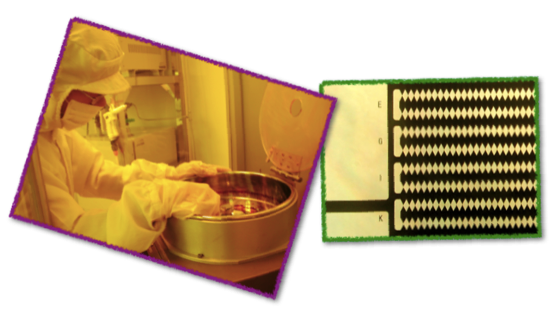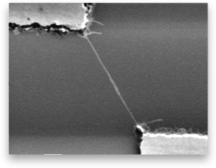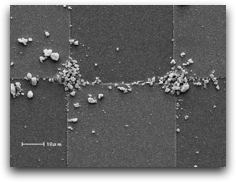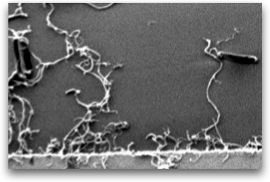Fabrication of nanomaterial-based sensor using dielectrophoresis


Interest in nanomaterials has been growing rapidly for the past several years. For example, carbon nanotubes (CNTs) are promising as new materials for a variety of potential applications. Recently, CNT-based gas sensors have received considerable attention because of their outstanding properties, such as faster response, higher sensitivity, lower operating temperature and wider variety of gases that may be detected compared with the other types of gas sensors. The CNT-based gas sensing utilizes a change in an electrical property due to adsorption of gas molecules as the output signal. This means that CNTs need to be electrically connected to the external measuring circuit. We developed a novel method of fabricating a CNT-based gas sensor using dielectrophoresis (DEP). The DEP fabricated CNT sensor can detect low concentration (ppm level) toxic gases such as NO2 and NH3 at room temperature.

One advantage of the ac electrokinetic manipulation technique is that one can quantify the amount of trapped CNTs on a real time basis by monitoring electrical impedance of the sensor (dielectrophoretic impedance measurement, DEPIM). This feature enables to control the CNT sensor response. The other advantage is that various combinations of nanomaterials and the microelectrode materials can be realized because two processes of the nanomaterial synthesis and the sensor fabrication are separated. The DEP fabrication method has been successfully applied to the other type of nanomaterials, such as carbon nanohorn, ZnO nanowire and palladium (Pd) nanoparticles. By DEP trapping CNTs on aluminum (Al) microelecrode, Schottky-type NO2 gas sensor with faster response can be fabricated.

DEP fabrication technique also realizes a higher order structure composed of several different kinds of nanomaterials. The composite nanostructure can be readily obtained by simultaneous DEP trapping of various nanomaterials mixed and suspended in an aqueous medium. A more controlled structure may be realized by DEP trapping these nanomaterial, which are separately suspended and individually DEP trapped using a multi-flow system. The higher order structure composed of several different kinds of nano and biomaterials can realize nano-sized interfaces, which may improve the sensor performance.
- Solution-based fabrication of carbon nanotube gas sensor by using dielectrophoresis and spin-columnchromatography
Advanced Materials Research, Volume 699, 2013, Pages 915-920
H. Watanabe, H. Komure, M. Nakano and J. Suehiro
abstract - Dielectrophoretic assembly of semiconducting carbon nanotubes separated and enriched by spin column chromatography and its application to gas sensing
Jpn. J. Appl. Phys., Volume 51, Issue 4, PART 1, April 2012, Article number 045102 (6 pages)
M. Nakano, M. Fujioka, K. Mai, H. Watanabe, Y. Martin and J. Suehiro
abstract - Separation and enrichment of semiconducting carbon nanotubes and its application to highly sensitive carbon nanotube gas sensor
2011 IEEE Nanotechnology Materials and Devices Conference (NMDC 2011), 2011, Article number 6155387, Pages 403-407
M. Fujioka, H. Watanabe, Y. Martin, M. Nakano and J. Suehiro
abstract - Fabrication and characterization of nanomaterial-based sensors using dielectrophoresis
Biomicrofluidics, Volume 4, 2010, 3430535 (10 pages)
J. Suehiro
abstract
- Bacterial detection using a carbon nanotube gas sensor coupled with a microheater for ammonia synthesis by aerobic oxidization of organic components
IET Nanobiotechnology, Volume 3, Issue 2, 2009, Pages 15-22
J. Suehiro, N. Ikeda, A. Ohtsubo and K. Imasaka
abstract
- Fabrication of bio/nano interfaces between biological cells and carbon nanotubes using dielectrophoresis
Microfluidics and Nanofluidics, Volume 5, Number 6, December 2008, Pages 741-747
J. Suehiro, N. Ikeda, A. Ohtsubo and K. Imasaka
abstract
- Aligned growth of ZnO nanowires and lasing in single ZnO nanowire optical cavities
Applied Physics B: Lasers and Optics, Volume 90, Numbers 3-4, March 2008, Pages 539-542
R.Q. Guo, J. Nishimura, M. Matsumoto, M. Higashihata, D. Nakamura, J. Suehiro and T. Okada
abstract
- Fabrication of interfaces between carbon nanotubes and catalytic palladium using dielectrophoresis and its application to hydrogen gas sensor
Sensors and Actuators B: Chemical, Volume 127, Issue 2, 15 November 2007, Pages 505–511
J. Suehiro, S. Hidaka, S. Yamane and K. Imasaka
abstract
- Carbon nanotube-based hydrogen gas sensor electrochemically functionalized with palladium
Proceedings of IEEE Sensors 2007, art. no. 4388458, pp. 554-557
J. Suehiro, S. Yamane and K. Imasaka
abstract
- Synthesis of nano-structured materials by laser-ablation and their application to sensors
Applied Surface Science, Volume 253, Issue 19, 31 July 2007, Pages 7840-7847
T. Okada and J. Suehiro
abstract
- Gas sensor using single-wall carbon nanohorns
Advanced Powder Technology, Vol. 18, No. 4, pp. 455–466, 2007
N. Sano, M. Kinugasa, F. Otsuki and J. Suehiro
abstract
- Application of dielectrophoresis to fabrication of carbon nanohorn gas sensor
Journal of Electrostatics, Volume 64, Issue 6, June 2006, Pages 408-415
J. Suehiro, N. Sano, G. Zhou, H. Imakiire, K. Imasaka and M. Hara
abstract
- Dielectrophoretic fabrication and characterization of a ZnO nanowire-based UV photosensor
Nanotechnology, Volume 17, No. 10, 28 May 2006, Pages 2567-2573
J. Suehiro, N. Nakagawa, S. Hidaka, M. Ueda, K. Imasaka, M. Higashihata, T. Okada and M. Hara
abstract
- Schottky-type response of carbon nanotube NO2 gas sensor fabricated onto aluminum electrodes by dielectrophoresis
Sensors and Actuators B: Chemical, Volume 114, Issue 2, 26 April 2006, Pages 943-949
J. Suehiro, H. Imakiire, S. Hidaka, W. Ding, G. Zhou, K. Imasaka and M. Hara
abstract
- Controlled fabrication of carbon nanotube NO2 gas sensor using dielectrophoretic impedance measurement
Sensors and Actuators B: Chemical, Volume 108, Issues 1-2, 22 July 2005, Pages 398-403
J. Suehiro, G. Zhou, H. Imakiire, W. Ding and M. Hara
abstract
- Fabrication of a carbon nanotube-based gas sensor using dielectrophoresis and its application for ammonia detection by impedance spectroscopy
J. Phys. D: Appl. Phys., Vol.36, pp.L109-L114, 2003
J. Suehiro, G. Zhou and M. Hara
abstract
> Back to the Research Top